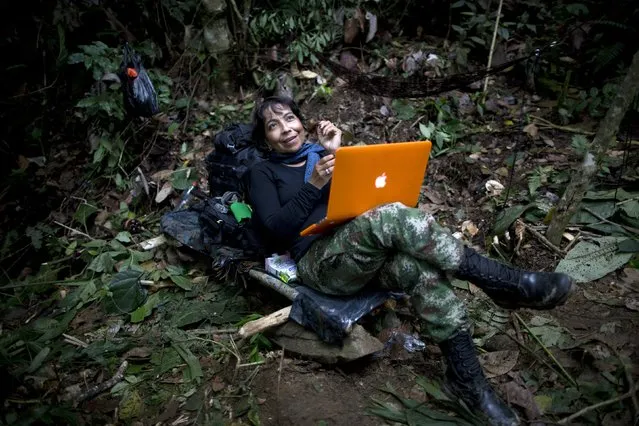
In this January 4, 2016 photo, Yira Castro, a mid-level commander for the 36th Front of the Revolutionary Armed Forces of Colombia, or FARC, looks up from her laptop at a hidden camp in Antioquia state, in the northwest Andes of Colombia. After three decades in the jungle her loyalty is absolute, she says that if peace does arrive the first thing she'll do is take a trip alone with her boyfriend, a fellow rebel. (Photo by Rodrigo Abd/AP Photo)
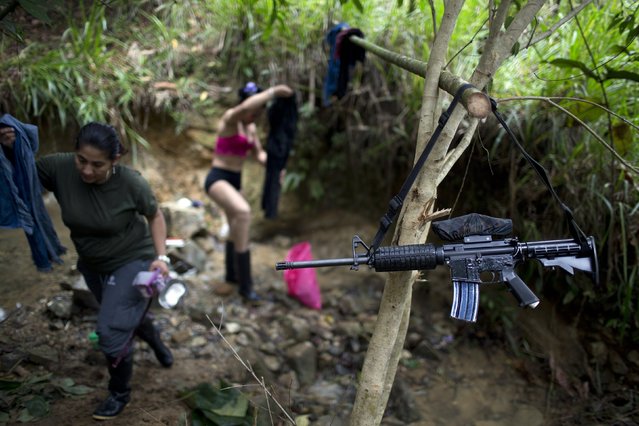
In this January 4, 2016 photo, the weapon of a rebel fighter for the 36th Front of the Revolutionary Armed Forces of Colombia, or FARC, hangs from a branch serving as a makeshift clothesline, near a rebel camp, in Antioquia state, in the northwest Andes of Colombia. “We’ll lay aside our weapons, like the accord says, but never hand them over”, says Juan Pablo, a commander of the 36th Front. (Photo by Rodrigo Abd/AP Photo)
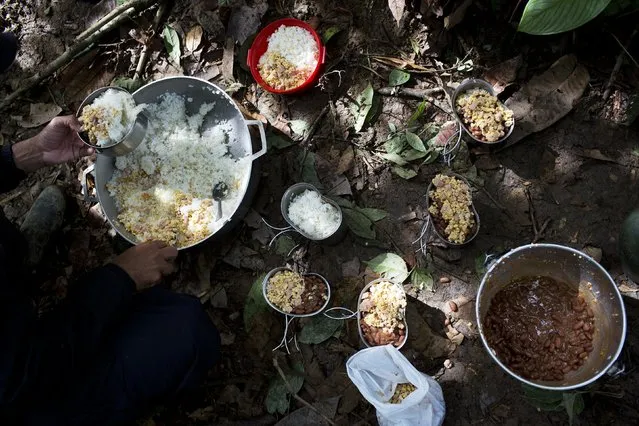
In this January 4, 2016 photo, a rebel soldier of the 36th Front of the Revolutionary Armed Forces of Colombia, or FARC, serves up a portion of rice, eggs, sausage and beans, for breakfast, at a hidden camp in Antioquia state, in the northwest Andes of Colombia. If the FARC seems at times stuck in a time warp, rebels share an enormous gratitude to the insurgency for rescuing them from poverty, providing them with a “family” and sense of belonging. (Photo by Rodrigo Abd/AP Photo)
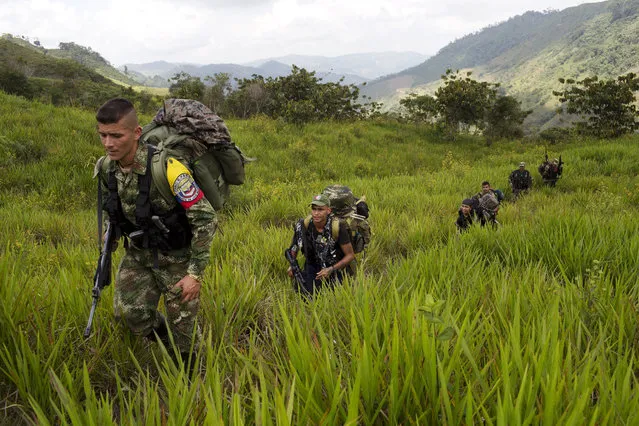
In this January 6, 2016 photo, members of the 36th Front of the Revolutionary Armed Forces of Colombia or FARC, trek to a new camp in Antioquia state, in the northwest Andes of Colombia. Big guerrilla camps are a thing of the past, the rebels now move in smaller groups. The 36th Front is comprised of 22 rank and file fighters, 4 commanders and 2 dogs. (Photo by Rodrigo Abd/AP Photo)
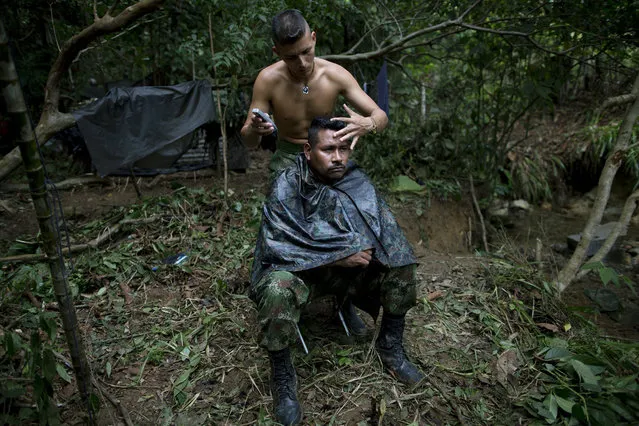
In this January 5, 2016 photo, Alexis, a 24-year-old rebel fighter, trims the hair of Juan Pablo, a commander of the 36th Front of the Revolutionary Armed Forces of Colombia, or FARC, at their camp, hidden in the northwest Andes of Colombia, in Antioquia state. Now, after 25 years plotting ambushes and assembling land mines, peace is within reach and for the first time Juan Pablo is thinking about his own future outside this jungle hideout. (Photo by Rodrigo Abd/AP Photo)
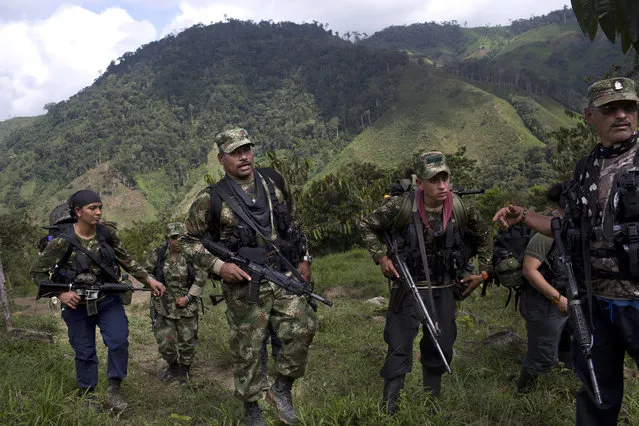
In this January 6, 2016 photo, Juan Pablo, center, a commander of the 36th Front of the Revolutionary Armed Forces of Colombia, or FARC, walks with his comrades in Antioquia state, in the northwest Andes of Colombia. As a commander of the 36th Front, one of the most militarily-active in a half century of warfare, the 41-year-old is capable of reciting verbatim passages from Fidel Castro's speeches even though he's never been to the movies, driven a car or eaten in a restaurant. (Photo by Rodrigo Abd/AP Photo)
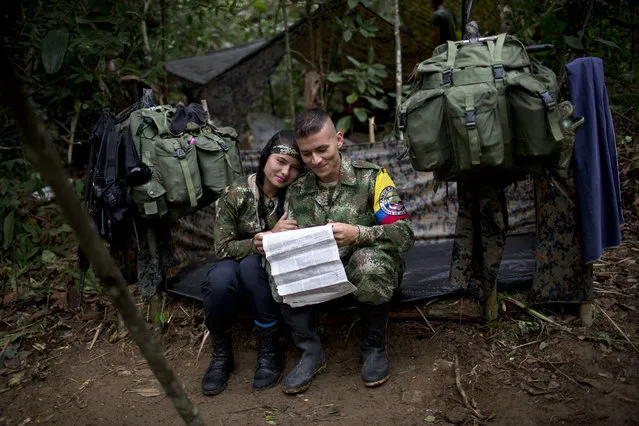
In this January 4, 2016 photo, Juliana, a rebel soldier of the 36th Front of the Revolutionary Armed Forces of Colombia, or FARC, sits her with boyfriend Alexis, in their makeshift tent, inside their hidden camp in Antioquia, Colombia. “Inside the guerrilla we don’t touch money, everything is given to us, from medicine to cigarettes. That’s why there’s no dependency in which she expects me to provide for her as is common in Latin America”, explains Alexis. “Between us there’s just love”. (Photo by Rodrigo Abd/AP Photo)
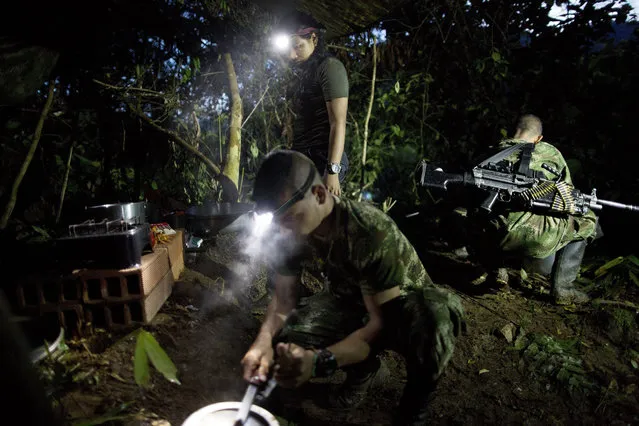
In this January 3, 2016 photo, with the aid of head lamps, rebel fighters for the 36th Front of the Revolutionary Armed Forces of Colombia or FARC, prepare a breakfast of rice, beans, sausages and coffee, in their hidden camp in Antioquia state, in the northwest Andes of Colombia. The day begins around 4:30 a.m. inside the temporary camp, home to 22 rank and file fighters, 4 commanders and 2 dogs. All rank and file are expected to share in kitchen patrol. (Photo by Rodrigo Abd/AP Photo)
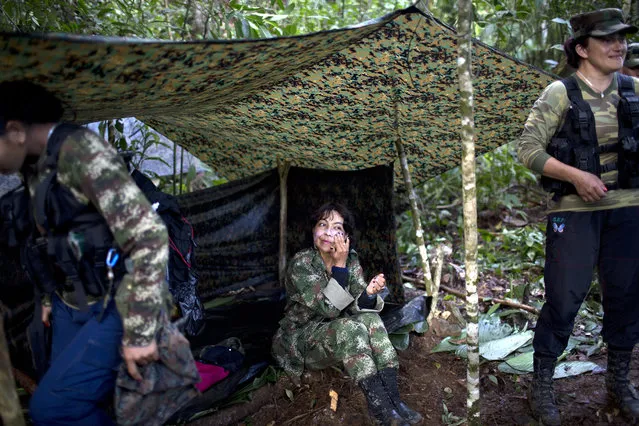
In this January 4, 2016 photo, Yira Castro, a mid-level commander for the 36th Front of the Revolutionary Armed Forces of Colombia or FARC, rubs moisturizing creme on her face, in a hidden camp in Antioquia state, in the northwest Andes of Colombia. Castro is a sort-of den mother to other female rebels who in the FARC have found a sense of empowerment they say is lacking in macho Colombian society. (Photo by Rodrigo Abd/AP Photo)
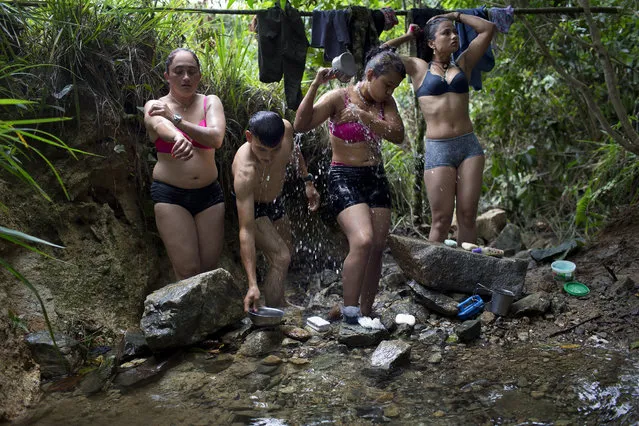
In this January 4, 2016 photo, rebel fighters for the 36th Front of the Revolutionary Armed Forces of Colombia, or FARC, bathe in a creek near their hidden camp in Antioquia state, in the northwest Andes of Colombia. The rebel fighters share all facilities on equal terms. Many of them are couples and share sleeping quarters. (Photo by Rodrigo Abd/AP Photo)
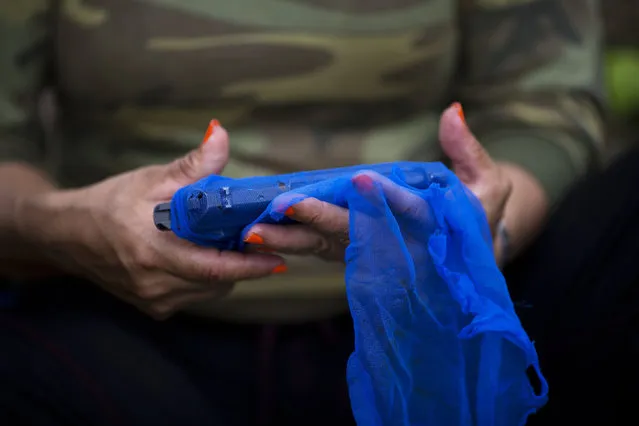
In this January 5, 2016 photo, Cindy, a rebel fighter for the 36th Front of the Revolutionary Armed Forces of Colombia, or FARC, wraps her gun in a mesh fabric, after a routine cleaning, as protection from humidity and rain, in a hidden camp in Antioquia state, in the northwest Andes of Colombia. Cindy is a field medic and she joined the guerrilla group when she was 18-years-old. “If there is peace with the government, we will have to take up politics, teach the people and later reunite with family after so many years”, she said. (Photo by Rodrigo Abd/AP Photo)
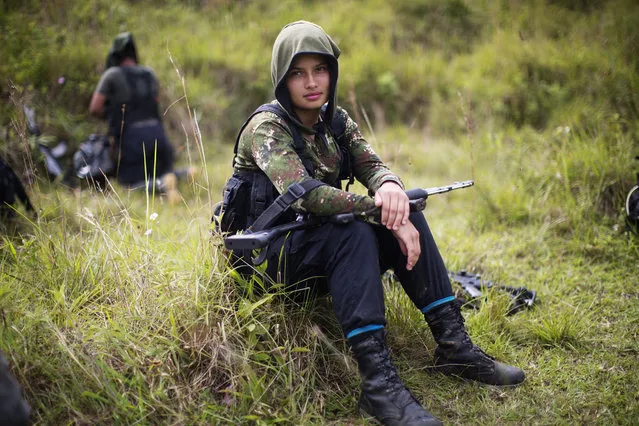
In this January 6, 2016 photo, Juliana, a 20-year-old rebel fighter for the 36th Front of the Revolutionary Armed Forces of Colombia, or FARC, rests from a trek in the northwest Andes of Colombia, in Antioquia state. Like many of her comrades in arms, her path to the FARC was born as much from personal tragedy as political ideology. In her case, she fled an impoverished home at age 16 and followed in the footsteps of an uncle after being raped by her stepfather. (Photo by Rodrigo Abd/AP Photo)
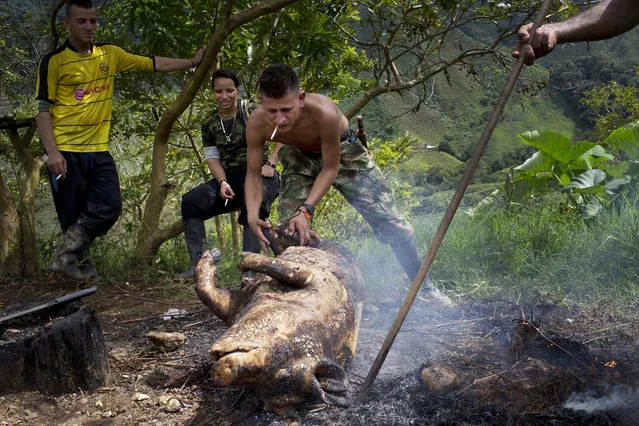
In this January 4, 2016 photo, Harrison, a rebel soldier of the 36th Front of the Revolutionary Armed Forces of Colombia, or FARC, drags the carcass of a hog to an open fire, for singeing to remove body hair, in their hidden camp in Antioquia state, in the northwest Andes of Colombia. The animal will be enough to feed the 26 members of the group for several days. (Photo by Rodrigo Abd/AP Photo)
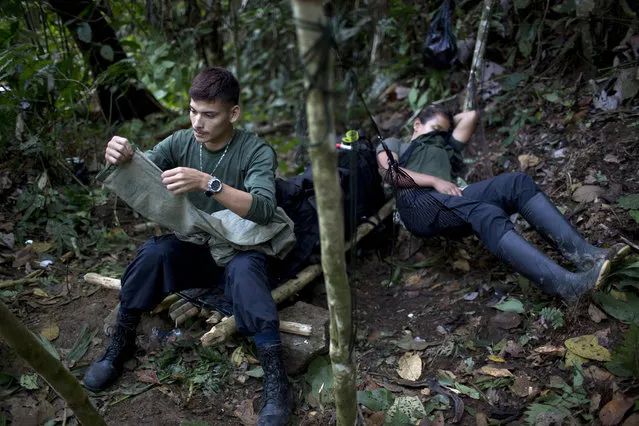
In this January 4, 2016 photo, Oscar, a rebel soldier for the 36th Front of the Revolutionary Armed Forces of Colombia, or FARC, mends a pair of pants while his “socia” Gisell rests in a hammock, in a hidden camp in Antioquia state, in the northwest Andes of Colombia. Inside the rebel organization, the idea of “socia” arose because the man cannot offer material wealth, so the girlfriends of the male rebels are referred to as a “socia” or partner. (Photo by Rodrigo Abd/AP Photo)
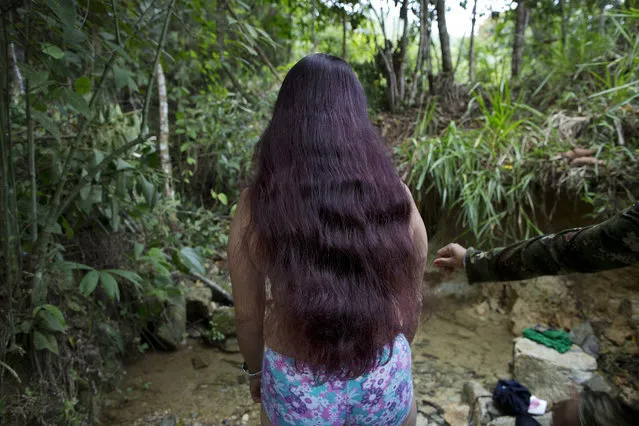
In this January 5, 2016 photo, Marcela, a rebel soldier of the 36th Front of the Revolutionary Armed Forces of Colombia, or FARC, stands at the edge of a brook where she is preparing to bathe, near the guerrilla's group hidden camp in Antioquia state, in the northwest Andes of Colombia. The rebels inhabit an impenetrable forest with South America’s only bear, venomous snakes and 20 species of exotic frogs. (Photo by Rodrigo Abd/AP Photo)
22 Jan 2016 10:45:00,
post received
0 comments
